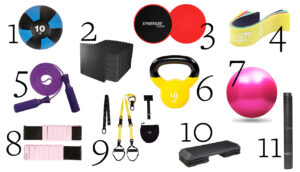Have you ever found yourself scrolling through Instagram or TikTok, watching fitness influencers show off their incredible at-home workout routines, and wondering how they stay so fit and healthy without ever setting foot in a gym? The good news is that you don’t need expensive gym equipment or a personal trainer to get in shape.
With creativity and determination, anyone can create an effective at-home workout routine that fits their lifestyle and helps them achieve their fitness goals. In this article, we will explore the benefits of at-home workouts and provide practical tips and ideas to create your workout routine so that you can get fit and healthy from home.
Benefits of At-Home Workouts

At-home workouts have become increasingly popular, especially with the rise of fitness apps, online classes, and virtual personal training sessions. There are many benefits to working out at home, including the following:
Convenience:
One of the most significant advantages of at-home workouts is convenience. You can exercise whenever you want, without having to leave your house. This means you can fit in a workout even if you have a busy schedule or can’t attend the gym.
Cost-effective:
At-home workouts can be a great way to save money on gym memberships or personal training sessions. Many fitness apps and online classes are free or cheap, making staying fit on a budget easier.
Time-efficient:
Since you don’t have to travel to the gym, at-home workouts can save you time. You can get in a quick workout before work, during your lunch break, or in the evening without commuting extra time.
Personalized:
With at-home workouts, you can choose the exercise that works best for you. You can tailor your training to your fitness level and personal preferences, whether doing yoga, weightlifting, or cardio.
Privacy:
For some people, the gym can be an intimidating place. With at-home workouts, you can exercise in the privacy of your own home without feeling self-conscious.
Accessibility:
At-home workouts are accessible to everyone, regardless of location or physical ability. You don’t need to live near a gym or have access to special equipment to stay fit.
Increased Consistency:
Consistency is the key to achieving fitness goals; at-home workouts can help you stay on track. Since you can work out whenever you want, you’re more likely to stick to your routine and make exercise a habit.
Overall, at-home workouts offer many benefits, including convenience, cost-effectiveness, time efficiency, personalization, privacy, accessibility, and increased consistency. With so many online resources, there’s never been a better time to start incorporating at-home workouts into your fitness routine.
Creating a Space for At-Home Workouts
Before starting an at-home workout routine, creating a dedicated space for exercising is important. This could be a spare room, a living room corner, or even your backyard. Ensure you have enough space to move around and clear any obstacles or hazards to avoid injury. Additionally, ensure the area is well-ventilated and well-lit to avoid feeling cramped or uncomfortable.
Equipment Needed for At-Home Workouts

While some at-home workouts can be done without equipment, others may require some basic equipment to maximize your workout. Here are some essential items to consider:
Yoga Mat:
A yoga mat is essential for anyone who wants to do yoga, Pilates, or any other floor-based exercises. It provides a non-slip surface that will help prevent injuries and make your workouts more comfortable. It also protects your floors from damage caused by sweat and other liquids. A good yoga mat should be at least 1/4 inch thick and made from a non-toxic material.
Resistance Bands:
Resistance bands are versatile and affordable equipment that can help you add resistance to your workout without the need for heavy weights. They come in different resistance levels, and you can use them to target other muscle groups. You can also adjust the tension by shortening or lengthening the band. Resistance bands are lightweight, easy to store, and can be used for various exercises, including bicep curls, squats, and leg extensions.
Dumbbells:
Dumbbells are a classic piece of gym equipment that can help you build strength and tone your muscles. They come in different weights, and you can use them to perform various exercises, including bench presses, shoulder presses, and bicep curls. Dumbbells are also versatile and can be used in many different workout routines. If you’re starting, consider a set of lighter weights and gradually work to heavier ones.
Jump Rope:
A jump rope is an excellent piece of cardio equipment that can help you burn calories and improve your cardiovascular health. It’s also lightweight and portable, making it easy to take when traveling. Jump ropes come in different styles; you can adjust the length to suit your height. You can use a jump rope to perform various exercises, including high-intensity interval training (HIIT) and endurance training.
Stability Ball:
A stability ball is a large inflatable ball that can help you improve your balance and core strength. It’s also an excellent piece of equipment for anyone who wants to work on their posture. You can use a stability ball to perform various exercises, including sit-ups, planks, and back extensions. When choosing a stability ball, ensure it’s the right size for your height.
At-Home Workout Routines
Countless at-home workout routines are available online, from yoga and Pilates to HIIT and strength training. Here are some examples of at-home workouts to consider:
Yoga:
Yoga is an ancient practice focusing on breathing, meditation, and body postures to enhance physical and mental well-being. It is a low-impact exercise that can help improve flexibility, balance, and strength. Some popular yoga styles that can be done at home include Hatha, Vinyasa, and Ashtanga yoga. Numerous online resources and apps offer guided yoga sessions for beginners and advanced practitioners.
HIIT:
High-Intensity Interval Training (HIIT) is a workout routine that involves short bursts of intense exercise followed by brief rest periods. It can be done with bodyweight exercises or equipment such as resistance bands or dumbbells. HIIT workouts can be done relatively quickly and have been shown to improve cardiovascular health, increase strength and endurance, and boost metabolism. Many online resources and apps offer guided HIIT workouts with varying durations and intensity levels.
Strength training:
Strength training is a form of exercise that focuses on building muscle and strength through resistance training. It can be done using bodyweight exercises or incorporating equipment such as dumbbells or kettlebells. Some popular strength training exercises that can be done at home include squats, lunges, push-ups, and planks. Strength training has been shown to help increase bone density, reduce the risk of injury, and improve overall physical performance.
Cardiovascular exercise:
Cardiovascular exercise, also known as cardio, is any exercise that increases your heart rate and breathing. It can be done through running, cycling, dancing, or jumping jacks. Cardio workouts can be done at home without equipment or using a treadmill, stationary bike, or elliptical machine. Regular cardiovascular exercise has been shown to improve heart health, reduce the risk of chronic diseases, and boost overall fitness levels.
It is important to note that before starting any new workout routine, it is advisable to consult with a healthcare professional, especially if you have any pre-existing medical conditions or injuries. It is also recommended to start with lower-intensity workouts and gradually increase intensity and duration as your fitness level improves.
Tips for Staying Motivated

While at-home workouts are convenient, they can also be challenging. Here are some tips for staying motivated:
Set realistic goals:
Setting realistic and achievable goals can help keep you motivated. It’s important to recognize your current fitness level and set possible targets. Break down larger goals into smaller, manageable ones and celebrate each accomplishment. This will give you a sense of achievement, motivating you to continue working towards your fitness goals.
Create a workout schedule:
Having a set workout schedule can help you stay on track and motivated. Plan your workouts ahead of time and include them in your daily or weekly program. This will help you make exercise a part of your routine, making you more likely to stick to it. You can also create a workout calendar to help you visualize your progress and stay accountable.
Find a workout buddy:
Having a workout partner can provide accountability and motivation. Having someone to exercise with can make the experience more enjoyable and help you stay on track. You can also challenge and push each other to reach your fitness goals. If you need help finding a workout buddy in person, consider joining an online fitness community for support.
Track your progress:
Tracking your progress can be a powerful motivator. Keep track of your workouts, including the exercises, sets, and reps you do. Take progress photos or measurements regularly to see how your body changes. Celebrate your progress and use it as motivation to keep going.
Mix it up:
Doing the same workout routine every day can get boring and demotivating. Mix up your workouts by trying new exercises, adding weights or resistance, or incorporating different activities like yoga, Pilates, or HIIT. This will keep your workouts fresh and challenging, making you less likely to get bored.
Reward yourself:
Rewarding yourself for reaching your fitness goals can be a great motivator. Choose a reward you’ll enjoy, such as a massage, a new workout outfit, or a healthy meal at your favorite restaurant. Tips will give you something to look forward to and help you stay motivated to reach your goals.
Visualize your success:
A visualization is a powerful tool that can help you stay motivated. Visualize yourself achieving your fitness goals and how you’ll feel when you reach them. Use positive affirmations to reinforce this visualization and remind yourself that you can achieve your goals.
Stay positive:
Staying positive can be difficult when you’re not seeing progress as quickly as you’d like, but staying focused on your goals and remaining positive is important. Surround yourself with positive influences, whether supportive friends or uplifting music. Remember why you started your fitness journey and keep pushing towards your goals.
Conclusion!
In conclusion, At-home workout routines can be great for beginners, especially if you live in an area where you have access to good parks or trails or are willing to travel. Even so, if you live in a busy city and find it difficult to get away from work or struggle with motivation, at-home workouts will give you a different intensity than gym workouts.
Plus, some at-home workout routines take a long time to complete, leaving you with little time to do anything else during the day. This can lead to burnout, frustration, and disappointment. Read my guide on How to Work Out at Home for more information.
FAQs!
What workout routine should I do at home?
Many workout routines can be done at home, depending on your fitness level, goals, and available equipment. Here are some general guidelines to keep in mind:
- Warm-up: Always start with a 5-10 minute warm-up to get your heart rate up and loosen up your muscles. You can do light cardio, such as jumping jacks, jogging in place, or dynamic stretching.
- Strength Training: Incorporate strength training exercises to build and maintain muscle. Bodyweight exercises such as push-ups, squats, lunges, and planks are great options that can be done without equipment. You can also use resistance bands or dumbbells if you have them.
- Cardio: Include cardiovascular exercises to improve your endurance and burn calories. If you have the equipment, you can do jumping jacks, burpees, mountain climbing, running, or bike.
- Cool-down: End your workout with a 5-10 minute cool-down, such as stretching or yoga, to prevent injury and promote recovery.
What is a good 5-day workout routine at home?
A good 5-day workout routine at home could include:
Day 1: Upper Body Strength (push-ups, dumbbell rows, overhead press, bicep curls)
Day 2: Cardio (running, jumping jacks, burpees)
Day 3: Lower Body Strength (squats, lunges, calf raises)
Day 4: Yoga or Pilates (stretching and strengthening exercises)
Day 5: Full Body Workout (planks, burpees, mountain climbers, kettlebell swings)
Is it OK to do a home workout every day?
Daily home workouts are generally safe if you give your muscles enough time to recover and avoid overtraining. You can alternate between different muscle groups and mix up your workouts to prevent boredom and reduce the risk of injury. Listen to your body and adjust the intensity and duration of your workouts as needed.
